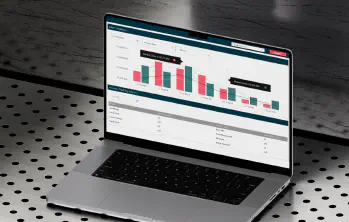Emerging threats and the importance of market abuse surveillance
Investment markets are dynamic and can change and adapt to different situations and scenarios. This has led to a constant battle: locking down existing cases of market abuse while trying to pre-empt emerging trends and leading to the question - how do firms capture risk that has not yet been defined?
The introduction of innovative technology and the emergence of AI, with a more structured and controlled regulatory environment, are helping. However, it is essential to have market abuse surveillance services in place to protect not only your reputation but also the integrity of the marketplace.
The changing nature of market abuse
With the advent of modern technology, including AI and Machine Learning, we are now able to work with technologies that have the capacity to make independent decisions beyond the limits of the, more restricted and rule-based, algos they may replace.
A technical report by Cornell University demonstrated that a ChatGPT large language model had the capacity to not only insider deal (when it knows it shouldn’t) but also attempt to deceive management to obfuscate the reason for the trade. Whilst the capacity to lie to management is not restricted to large language models - how do regulators control AI when it has the ability to act beyond its supposed boundaries and who is responsible when it does?
Secondly, how can modern technology help mitigate these risks, and can large language models assist with the parsing of ever-larger volumes of data?
Market abuse monitoring commonly works using a rules-based exception process and effectively manages large volumes of message data. AI systems are not necessarily trading quicker or more often than algos or HFT systems, they are trading more intelligently, and existing market abuse monitoring rules should capture this behaviour effectively.
We are left with eComms Surveillance; where we see large volumes of message data that need to be analysed to construe intent. This is where ChatGPT large language models can be of use; in understanding the intent behind messages/conversations; allowing for more effective surveillance than a simple lexicon-based or a random sample-based approach.
Below, we look at some of the more common market abuse typologies together with examples of cases against those who have tried to profit from them.
Insider trading
The trading or placing/amending of orders on the possession of Material Non-Public Information (MNPI) provides an unfair advantage to the trader in question. It allows them to either profit or mitigate losses whilst simultaneously undermining the integrity of investment markets. In 2024 the FCA successfully brought a case against Mohammed Zina for Insider Dealing whilst working at Goldman Sachs; demonstrating the efficacy of Surveillance systems in finding this type of behaviour yet also highlighting the time taken to bring such cases to fruition (in this case 10 years).
Front running
Front Running is a specific form of Insider Trading wherein a broker buys/sells on his own or his company’s account prior to the execution of a known client order. In this case, the MNPI is the client order that would impact the market and unauthorised pre-hedging or Front Running is not allowed.
Market manipulation
There are many different forms of market manipulation but they all come under the broad umbrella of the creation of false and/or misleading impressions as to price or liquidity of the underlying instruments. Below we discuss some of the more commonly seen typologies together with appropriate real-world examples.
Spoofing
The advent of HFT and algorithmic trading systems has given rise to an increase in the number of spoofing cases found by regulators. Spoofing involves the placing of non-bonafide orders on one side of the order book with the intent of obtaining preferential pricing and moving the order book on the opposite side before cancelling said non-bonafide orders. The following case typifies spoofing; wherein a trader ‘falsely represented to the market an intention to buy/sell when his true intention was the opposite’.
Layering
Layering is an abusive behaviour akin to spoofing with the difference being that the non-bonafide orders are across multiple ‘layers’ of the order book with the intent (as per spoofing) to obtain preferential pricing on the opposite side. The following caseshows how individual traders can use algos/HFT patterns to exhibit this behaviour and the ability of regulators to identify, and prosecute, when it occurs.
Market rigging
When looking at the leading investment/money markets, it’s difficult to believe that market rigging is still a threat. While regulations are helping address this situation, we only need to look back at the LIBOR/EURIBOR scandal in 2012 when it was discovered that a group of banks and traders were inflating/deflating rates on a market that underpins trillions of dollars in derivatives. The FCA issued a record fine to Deutsche Bank for not only participating in the abuse but for misleading the regulator as to their participation.
Abusive short selling
Short selling is legal. Indeed, it plays an instrumental role in market liquidity, but abusive or naked short selling in tandem with spreading false information is illegal. There are now strict regulations regarding short selling and the facilitation of transactions with borrowed shares.
Ramping
Ramping is a form of market manipulation wherein there is a trading of a significant portion of a financial instrument or derivative, moving the price either up or down, when there is no news or obvious reason/trading rationale for the activity. Not only does this activity cause potential loss to investors it also undermines and damages confidence in the underlying market - as voiced in the following case led by the FCA.
Misuse of information
While insider trading and market manipulation involve the placing or executing of orders, misusing information, or starting untrue rumours to manipulate prices or investor activity, is also illegal. The idea that you have to trade to physically benefit from misusing information is outdated.
Regulatory support
While many forms of market abuse are difficult, if not impossible, to stamp out entirely, there is no doubt that an expanding regulatory framework has significantly reduced their impact whilst simultaneously increasing the capability of investigating and prosecuting malfeasance. The leading UK acts of Parliament and EU regulations relating to market abuse include:
- Financial Services Act 1986
- Financial Services and Markets Act 2000
- Market Abuse Directive (2003/6/EC) Implementation Regulations 2005 (since superseded by MAR below)
- Financial Services Act 2012
- Market Abuse Regulations (MAR) 2014/596/EU
Under the umbrella of the five regulatory acts listed above, we have seen the introduction and tweaking of various approaches to, and definitions of, market abuse. However, there remains a consistency of approach, with a broad distinction between market manipulation and insider dealing, yet an overarching purview for regulators to prosecute for abuse of regulated markets.
Emerging threats in market abuse
Whilst market abuse themes remain relatively constant there are, with the advent of tools for quicker decision-making and trading, increases in both the number of trades on exchanges and the commensurate risks of manipulation. Some emerging threats include:
- High-frequency trading using algorithms
When you combine high-frequency trading systems with cutting-edge algorithms, you have the potential for a market abuse strategy that can be over before slow traders even realise it started. The addition of AI that has the capacity to both ignore human-set boundaries (see the technical report by Cornell University at the start of this article) and act independently creates the risk for novel and potentially even cooperative multiple-model abuse strategies.
- Cryptocurrency market manipulation
With the crypto market currently worth in excess of $2.4 trillion there are a range of assets with different risk levels and exposure to manipulative practices. Whilst CEX’s are increasingly doing due diligence on listings, the prevalence of pump-and-dump schemes together with the risk of outright manipulation of less liquid instruments, has led to a perception that digital assets can not always be trusted.
In traditional markets a move of 5% would be significant, in crypto it can just be a Tuesday. Identifying the activity, whether individual or by those acting in collusion, and being able to escalate it to the relevant regulatory authorities is vital. The advent of MiCA in the EU, the ongoing regulation-by-enforcement in the USA and the UK’s HMT consultation papers are all putting cryptocurrency regulation at the forefront for those operating Central Limit Order Books.
- Social media
When you consider that Meta (Facebook/Instagram) is valued at $1.3 trillion, the Reddit IPO is rumoured to be valued at $6.5 billion, and Telegram is estimated to be worth circa $30 billion, this highlights the power and prevalence of social media. Rogue traders regularly use social media to facilitate the rapid dissemination of information and often baseless rumours. Whilst APIs exist that can trawl social media sites for information; the harmonising of that data into usable alerts that highlight not just intent, but impact, is an ongoing process.
- Derivatives and OTC markets
Cross-product manipulation is likely to be one of the focus points for regulators this decade. As computing power increases the capacity of surveillance systems to monitor for manipulative practices across financial instruments, whether in a direct or indirect causal relationship, also does - see Market Watch 73 (narrowing the spread) for an example thereof.
- Organised crime gangs
The FCA and other regulators are growing more concerned about the influence of organised crime gangs. The FCA regularly publishes a “Market Watch" newsletter and updates on various market abuse risks and whilst OCG are not types of market abuse they do highlight the risk of collaborative abuse schemes with multiple participants and the difficulties of analysing the dissemination of relevant communications.
The Importance of Trade Surveillance
Regarding market abuse, it has always been a case of fighting fire with fire. Today’s situation is no different, with high-tech dealing systems on the radar of high-tech market abuse surveillance services.
While we tend to look forward when considering surveillance systems, it’s crucial to appreciate the more recent technological advances. These include:-
- Real-time monitoring
- Integrating Big Data into the process
- Enhanced accuracy – reducing the ratio of false positives
Significant points of evolution over the years:
- A switch to detecting nuanced forms of market abuse
- Monitoring the interconnectedness between different asset classes
- Analysing textual data
- Increasing volumes of trade data
Overcoming ever-changing challenges in market abuse surveillance
Innovation is the key to the success of long-term global investment markets and the ability to move with the times. This presents a number of ever-changing challenges for those providing market abuse surveillance services such as eflow.
While we are renowned for our cutting-edge technology, there’s a lot more to consider, such as:
- Ongoing regulatory compliance
- Integration of different data sources
- The use of advanced analytics and technology
- Real-time monitoring
- Cross-market surveillance
- Detection of trading patterns
- Comprehensive risk assessment
- Information sharing and collaborations
- Ongoing training and education
- Continuous investment, improvements and adaptations
Each of these challenges in isolation will assist with detecting instances of market abuse, but the cumulative impact is considerably greater. Those looking to manipulate information flow and prices are constantly trying different approaches and strategies, but the wider the market surveillance net can be thrown, the greater the chances of identifying and disrupting these activities.
One of the main challenges is ensuring that market participants, governments, regulators, and those in the financial services industry are on the same page and pulling in the same direction.
Future directions in market abuse surveillance
Here at eflow, we appreciate the importance of market abuse surveillance, providing a comprehensive service to a growing number of clients around the world. Automation is the key, and enhanced speeds are critical, but collecting the right data in a timely manner and analysing it in a split-second is priceless.
The ongoing threat of financial penalties for those failing to fulfil their market abuse surveillance obligations in terms of both adequate risk assessments and subsequent lines of defence will prompt many to introduce new systems and audit them appropriately. For most companies, the potential reputational damage will likely encourage them to act and take a forward-thinking approach to this ongoing problem.
Conclusion
As a company providing market abuse surveillance services, analysing vast amounts of data, identifying patterns and fulfilling our clients’ regulatory obligations, we tend to look forward to the next challenge. It can be helpful to stop for a moment and look back at the progress we have seen over the years..
Sometimes, we need to appreciate how far we have come, but we also know that there are still significant challenges ahead. Detecting instances of market abuse is critical from a regulatory standpoint and for the integrity of financial markets and their participants. We appreciate the ever-tightening regulatory oversight, the innovation of those looking to benefit from various types of market manipulation and the need for market participants to concentrate on their core business.
Feedback from clients shows that we are making a real difference. We help create the foundations for businesses to grow while protecting their clients. If you would like to chat about your market abuse surveillance needs, please feel free to contact us.



